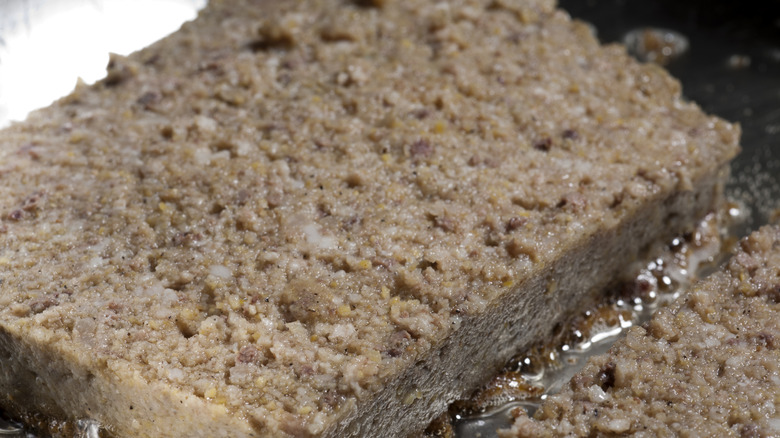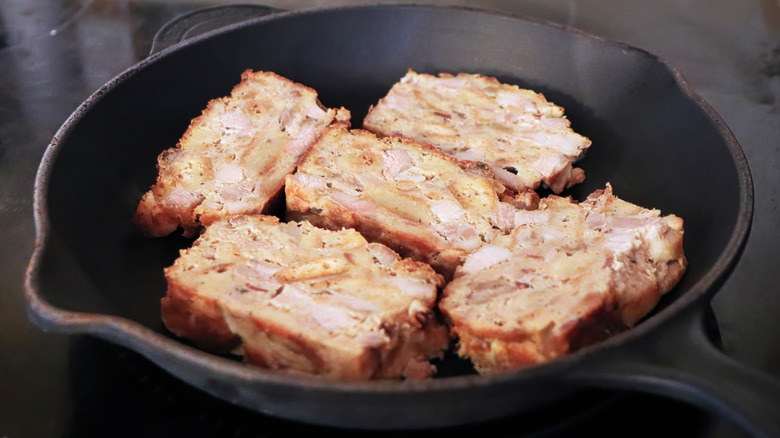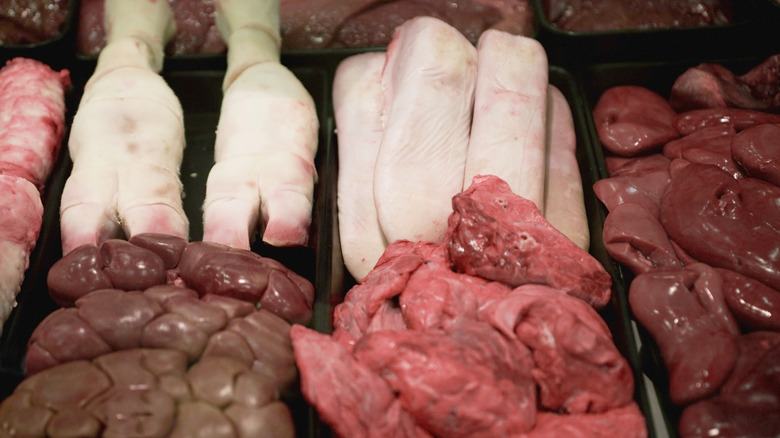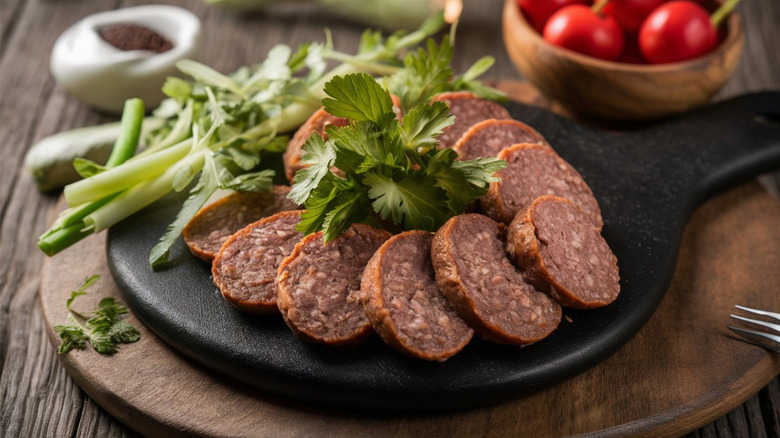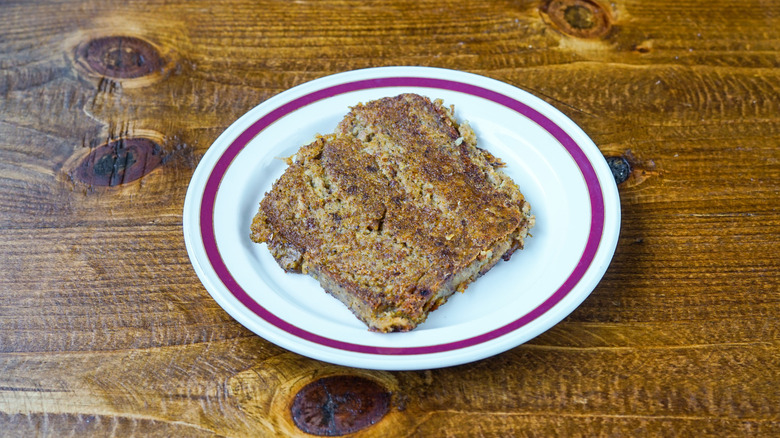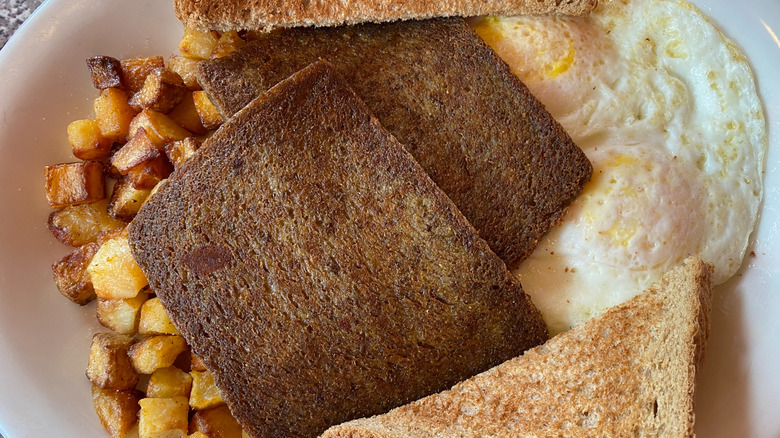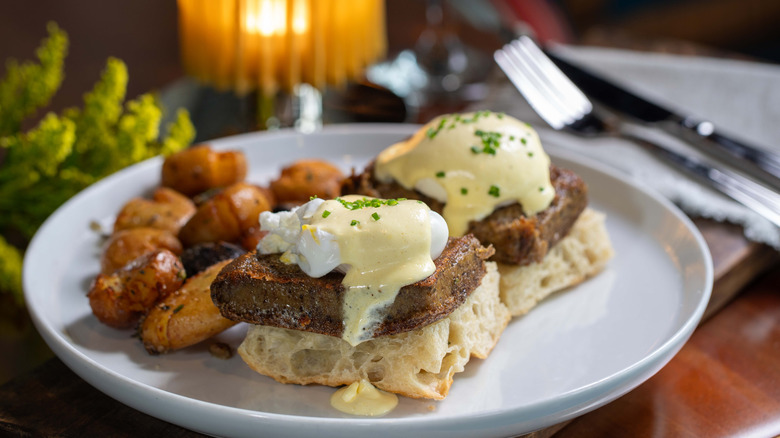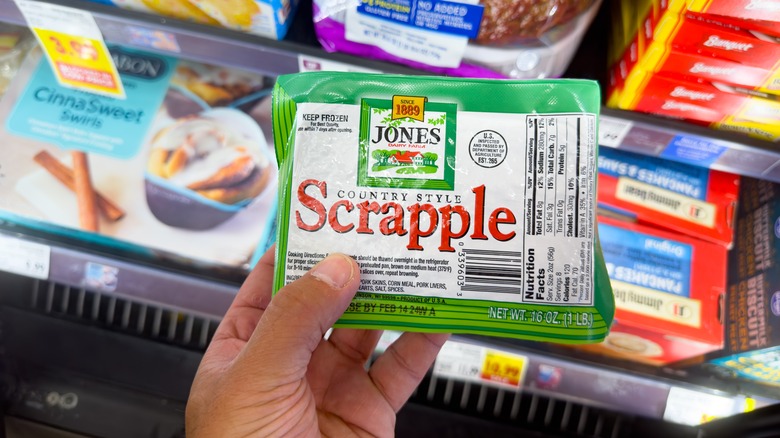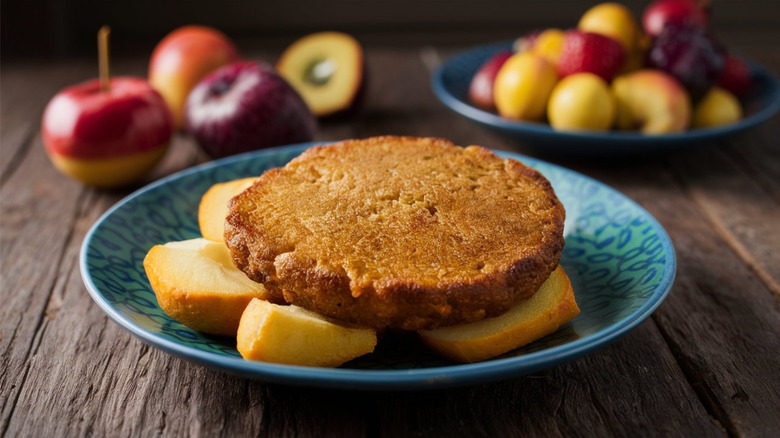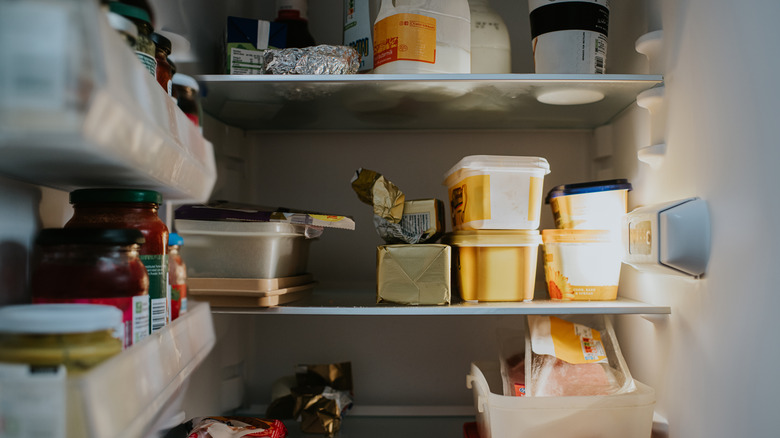Pennsylvania Dutch Cooks Explain What Scrapple Is And What It Tastes Like
We may receive a commission on purchases made from links.
Common in Pennsylvanian Dutch cuisine, scrapple is a unique food rooted in traditional home cooking and thrifty money-saving techniques. The name scrapple comes partially from the word scraps as this dish was often made to use up the bones and leftover meat on a carcass and to ensure that nothing got wasted. It's still eaten today in mid-Atlantic states and is closely related to other meat and grain-based dishes around the world, such as Scotch haggis or alheira sausage – a popular Portuguese dish you should try at least once if you love meaty foods.
To learn more about scrapple, we spoke to two experts who know how to make it from scratch. George Clayton is the director of sales and marketing for Stoltzfus Meats, which specializes in Pennsylvania Dutch dishes, while Chris Reed works for Stockyard Sandwich Co. in Philadelphia, an eatery that serves homemade scrapple. They talked us through this Pennsylvania Dutch staple and explained why you should introduce some scrapple to your diet.
Where does scrapple come from?
According to George Clayton, "Scrapple has both Dutch and German origins. Farmers started making [it] to use up trimmings from the pig." It is traditionally served as a breakfast food and was brought to America by central European immigrants, who settled widely in Pennsylvania and the Mid-Atlantic region throughout the 1600s and 1700s. The original scrapple recipe called for pork offcuts, such as head meat, hocks, and organs — otherwise known as offal — which could not be turned into sausages.
The American scrapple recipe diverged from German scrapple — originally called panhas — when settlers began to add cornmeal to thicken the mixture into a loaf. Similar to meatloaf, which was once a breakfast food, blended scrapple is poured into a tin to set and can then be reheated as and when. Traditional Pennsylvania scrapple is still popular and can be found on restaurant menus throughout Ohio, Philadelphia, Maryland, and Delaware.
How do you make scrapple?
Chris Reed explains that "scrapple is made by braising and picking pork shoulder then cooking cornmeal in the pork drippings with a healthy amount of black pepper and some salt." Traditionally, the pork offcuts are boiled on the bone in a large pan of water so the marrow leeches out and adds collagen and flavor to the broth. Once the meat has been cooked for 2-3 hours, you should remove it from the liquid and, after letting it cool, pull all the meat off the bones and strain your stock.
Add cornmeal, buckwheat, or wheat flour to around five cups of stock and cook until it thickens. Grind or blend the meat with the spices until you get a coarse texture. Along with black pepper and salt, seasoning scrapple with sage is common. Then, add this ground mixture to the liquid and stir it thoroughly before pouring it into a loaf tin and leaving it to harden in the fridge.
The fatty texture of scrapple means that it should hold its form and become sliceable. It's a pretty simple recipe to make at home, as long as you have a large amount of pork offcuts on hand. However, because the recipe can involve slicing up meat, you will want to use a sharp knife or learn how to use a whetstone without ending up in the emergency room before you attempt it.
Is scrapple the same as goetta?
Scrapple has several variants that originate from around the same geographical region. One scrapple-like food that is common in Ohio is goetta. While scrapple and goetta are considered different foods, the recipes are largely the same. Chris Reed notes that "the only difference between scrapple and goetta is that scrapple is made from cornmeal and goetta is made from oats."
Goetta is believed to be closer to the original German preparation and, like scrapple, is mainly served as a breakfast item. Scrapple also shares many similarities with livermush, which is mainly found in the more southern regions — particularly in North Carolina — and includes pork livers, meat scraps, and cornmeal. Scrapple and livermush are also quite similar to traditional breakfast sausage, except that breakfast sausage is made using pork mince and does not include cornmeal or oats.
Homemade breakfast sausage is also formed into patties by hand rather than into a loaf. You can easily replace your breakfast sausage with scrapple, though. A side helping of scrapple can be one of the best ways to take canned biscuits to the next level.
What does scrapple taste like?
Although some diners might feel intimidated by the idea of eating scrap meat, George Clayton explains, "The flavor [of scrapple] falls between country sausage and bacon. Some producers use more or less quantities of pepper, which can give a distinct taste as well." Essentially, scrapple's main flavors are meaty and spicy, with a strong porky taste. When cooked, scrapple generally has a crispy exterior texture that comes from pan frying or baking.
This crunchy bite makes scrapple comparable with bacon. However, scrapple does not have the greasy feel of bacon and is fairly light when it comes to breakfast meats. While the outside is crisped up due to the flour in the mixture, the inside remains moist and juicy.
Scrapple seasoning largely comes down to the individual recipe. While some scrapple producers stick mainly to salt and pepper, others may use cayenne pepper, paprika, or dried chili peppers to give it a fiery kick.
How is scrapple usually served?
Scrapple is often served as part of a fried breakfast, with other morning staples like eggs and toast. Chris Reed explains that perfectly prepared "scrapple should be about half an inch thick [and] cooked hard until crispy — nearly burnt on the outside and creamy on the inside." Much like Scottish haggis, the cornmeal gives scrapple a dense, soft texture inside, while panfrying lets you get a nice firm bite on the outer layer without transferring too much grease to the middle of the slice.
The creamy consistency pairs naturally with poached or fried eggs, while the salty, porky flavor and crisp shell mean that you can serve scrapple with maple syrup, just like you would serve syrup and bacon waffles. It's also one of the best ways to amp up your pancakes in the morning, and it goes well with scrambled eggs. Reed adds that scrapple can be delicious on a "cheese and egg sandwich slathered with maple syrup."
Are there different types of scrapple?
George Clayton explains that while most homemade scrapples follow a similar recipe, you can eat scrapple in a variety of ways depending on the reheating method. As Clayton notes, "people eat scrapple pan-fried, deep-fried, and baked, and each of these methods makes for different experiences in taste and texture." To pan-fry scrapple, you should make sure that you almost fully cover it in oil. This helps stop it from sticking to the bottom and ensures you get a crisp outer coating on all sides.
It is also common to coat scrapple in flour or use a flour, breadcrumb, and egg wash mix before pan frying, similar to pork schnitzel, as this gives it an extra crunch and helps it hold shape. You will need to flip your scrapple once in the pan to ensure it cooks evenly. Covering the scrapple in oil will help stop it from crumbling or falling apart when you try to move it.
You can also bake scrapple if you want to lower the fat content of your meal. To do this, you should place your scrapple slice on baking parchment to prevent it from sticking and cook it in the oven at 375 degrees Fahrenheit for 30-40 minutes. Baked scrapple has a slightly drier outer texture and a moist, chewy center. In addition to these different cooking methods, you can also find some scrapple varieties made with different meats, like turkey or beef.
Can you buy scrapple in stores?
While delicious homemade, George Clayton notes that you can also buy scrapple in stores. He explains that "[scrapple] is mainly sold in stores in the northeast part of the United States." Popular pre-made scrapple brands, like Habbersett or RAPA, are available from delicatessens and some Walmarts.
Habbersett and RAPA sell pork, turkey, and beef scrapple, and you can buy these brands at stores or online at Amazon. Store-bought scrapple usually comes in a readymade loaf shape in plastic packaging, making it easy to store at home and cut into slices when you're ready to eat. You can also buy frozen scrapple from stores and find fresh scrapple at some farmer's markets.
If you want to try authentic scrapple, it's best to purchase it from a specialty butcher shop or a restaurant that specializes in Pennsylvania Dutch cuisine. This will give you the most unique flavor experience and a good idea of what traditional scrapple tastes like.
Is scrapple a nutritious dish?
George Clayton suggests eating scrapple in the mornings because "the combination of nutrient-rich pork with healthy grains makes [it] a hearty breakfast item." Like many pork-based foods, homemade scrapple is high in iron, zinc, protein, and collagen from the pork stock and bone marrow. The carbs from the cornmeal or wheat flour also make scrapple a balanced food that will give you energy throughout the day.
A two-ounce slice of store-bought pork scrapple usually contains around 119 calories, with 70 of those calories coming from fat. Turkey scrapple is much lower in calories, with around 80 calories and four grams of fat per slice, making it a leaner option overall.
Scrapple is also high in cholesterol and saturated fats due to its meat content. The fact that scrapple is often fried in oil can also increase the calorie count, depending on how much oil you use and how much is absolrbed into the scrapple during cooking. While scrapple is more calorically dense than bacon, which has around 53 calories per slice, it is also more filling as a breakfast option because of the mixed-in grains.
How to store scrapple?
If you've made scrapple from scratch, you can either store it in the fridge or freeze it to eat later. Fresh scrapple will usually keep for around 3-5 days in the refrigerator wrapped in foil or stored in an airtight container. This will help it stay moist and help prevent it from absorbing odors or flavors from other foods stored nearby. If you buy scrapple vacuum sealed, however, it will have a longer shelf life.
Chris Reed explains that "the typical shelf life of scrapple is comparable to ham," meaning you can keep it for around 90 days when uncooked and vacuum sealed. Reed also notes that you can extend the shelf life of scrapple by freezing it. Frozen scrapple can be kept for around 3-5 months and should be tightly covered in foil or plastic wrap and then placed in an airtight tub for best results.
When you want to use your frozen scrapple, make sure you place it in the refrigerator around 24 hours before cooking to give it time to defrost. This will help you avoid one of the common mistakes everyone makes when cooking ground beef or other meats, which is defrosting them at room temperature and potentially risking bacteria growth and contamination to other non-refrigerated foods. You should also check the best before information on any packaged scrapple you buy.
Methodology slide
To write this article, I reached out to scrapple experts at a variety of restaurants and delicatessens to gather information about scrapple. Using these expert interviews and thorough online research from a variety of food blogs and nutritional sites, I was able to discover so much about this amazing meat.
